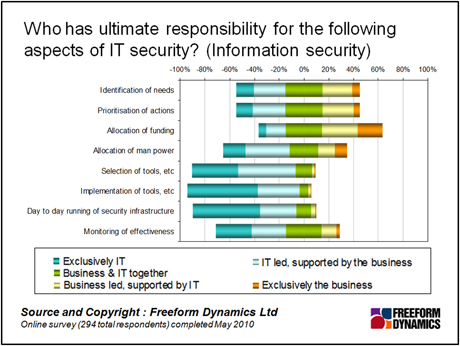I once read a book that said, among other things, “You can never truly give money away.” The point it was making was that the act of giving has a certain responsibility – if you hand a large wad of cash to a charity, for example, you will want to know that the money is being spent wisely.
A good theory perhaps, but it doesn’t fit very well with the golden rule of IT security – that the things we dislike, or don’t know how to deal with, can quickly be categorised as somebody else’s problem. In business as in daily life, people will – in principle – pay to have certain problems dealt with by others, with a flick of the hand and a cry of “make it go away”.
Just how much does this principle apply in security today? Well, like all good researchers, we thought we would ask the Reg audience in the form of a mini-poll.
The first question we asked in our most recent poll was: “Exactly who is involved in security decisions?” We asked questions around general security and information security, and the results came out much the same. As you can see from Figure 1, it certainly isn’t the case that the business leaves IT to just get on with it.

Figure 1
Indeed, there is a fair balance between the two sides when it comes to identifying needs and prioritising actions. Business is also prepared to stump up the money for security solutions, after which the reins are handed over to IT for tool selection, implementation and day to day running.
However, even at this stage there is room for the business to get involved, particularly when it comes to monitoring the effectiveness of the security environment. The business may not be entirely hands-on, but it is certainly not leaving security to the technicians alone.
This fact is illustrated by the other main question we asked, around security-related issues and challenges. As Figure 2 below shows, the main issue is not that too much is delegated to IT. Nor is it strictly that business users don’t care about IT security. More important than both of these factors is the challenge that business users and their management don’t fully appreciate the importance of certain aspects of IT security. And close second is that, despite attempting to flag any risks to business, IT will inevitably get the blame when things go wrong.

Figure 2
This raises a number of issues. While it appears to be the case that business and IT are prepared to get around a table and discuss security related matters, this doesn’t mean that the conversations are going to be easy. From the free text responses to the poll we can get a good idea of why – getting management to take specific security matters seriously and communicate their needs better comes up time and again. Examples include:
The business needs to realise that typical rules about return on investment do not apply.
Communication between the IT, HR and management groups – quit faffing and sort out your needs!
Security should be a part of training for senior management. Which would imply that senior management are competent to decide funding and priorities.
Upper management does not understand the risks and IT management is not good at explaining the risks in layman’s terms. There needs to be an intermediary who can communicate the risks to upper management, and then communicate back upper management’s concerns.
The situation is not perfect – some respondents report a “cavalier attitude”, for example. However, the responses suggest that business management is prepared to at least participate in a dialogue about the risks and what to do about them – even if it would rather not. Given this starting point, if we want to get to a better place with respect to security, requirements and constraints will need to be articulated in a way that helps the business get its priorities straight. It may be too much to ask for business leaders to fully get their heads around the detail of risk management, so the implication is that they need help in doing so.
In other words, and it pains me to say this, it looks like for the time being the initiative for information security still needs to start with IT. Perhaps, deep down, business management really does still see IT security as somebody else’s problem, or maybe such people do need to be handheld through the intricacies of what can seem to be a complex area. However, if they are prepared to at least come to the table, the least we can do from the IT side is help them understand how to take their responsibilities seriously.
Content Contributors: Jon Collins
Through our research and insights, we help bridge the gap between technology buyers and sellers.





Have You Read This?
From Barcode Scanning to Smart Data Capture
Beyond the Barcode: Smart Data Capture
The Evolving Role of Converged Infrastructure in Modern IT
Evaluating the Potential of Hyper-Converged Storage
Kubernetes as an enterprise multi-cloud enabler
A CX perspective on the Contact Centre
Automation of SAP Master Data Management
Tackling the software skills crunch